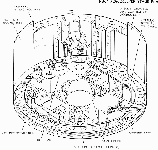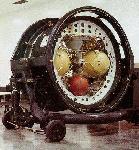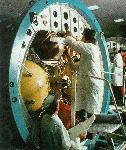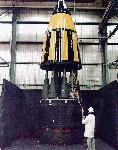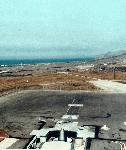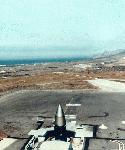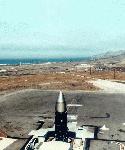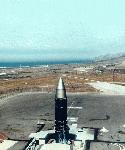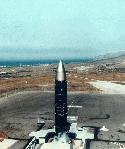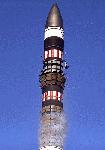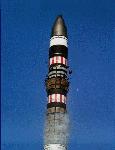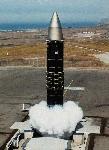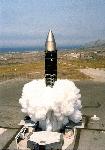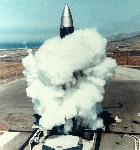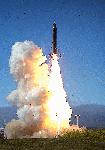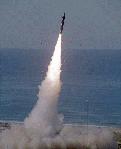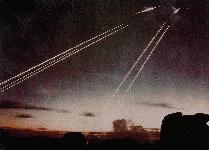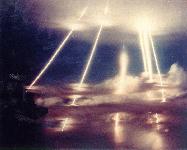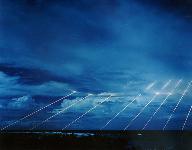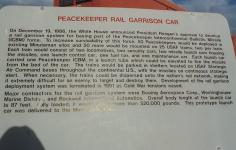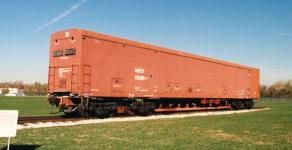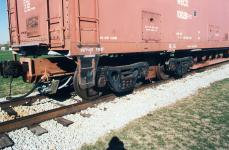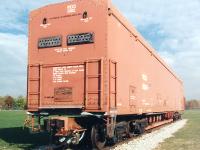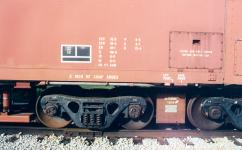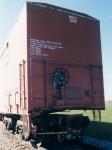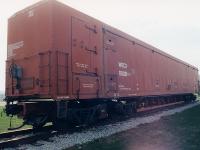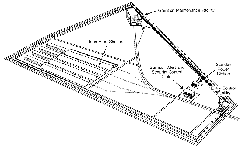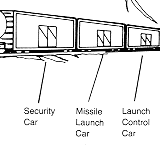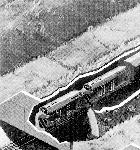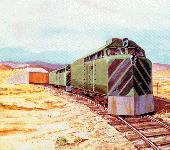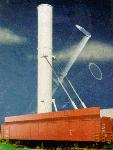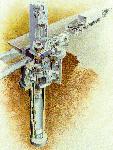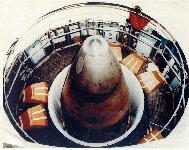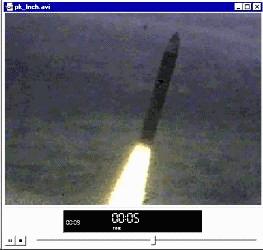





The Peacekeeper is a three-stage rocket ICBM system consisting of three major sections: the boost system, the post-boost vehicle system and the re-entry system.
The boost system consists of three rocket stages that launch the missile into space. These rocket stages are mounted atop one another and fire successively. Three of the four stages exhausted their solid propellants through a single adjustable nozzle which guided the missile along its flight path. Motorcases made of kevlar epoxy material held the solid propellants. The fourth stage post-boost vehicle employed a liquid bi- propellant rocket propulsion system to provide velocity and attitude correction for missile guidance. The post-boost vehicle also employed a self-contained inertial navigation system that allowed the missile to operate independent of ground reference or commands during flight.
The 28-foot first-stage solid-fuel rocket motor weighed approximately 108,000 pounds and is capable of boosting the missile to about 75,000 feet. The 18-foot long second-stage motor propelled the missile to an altitude of about 190,000 feet and weighed 60,000 pounds. The rocket motor in the eight-foot third stage weighed 17,000 pounds and supplied the thrust to boost the missile to about 700,000 feet. The 2,300 pound post-boost fourth stage vehicle was designed to maneuver the missile into position for the multiple reentry vehicles to deploy in their respective ballistic trajectories.
Following the burnout and separation of the boost system's third rocket stage, the post-boost vehicle system, in space, maneuvers the missile as its re-entry vehicles are deployed in sequence.
The post-boost vehicle system is made up of a maneuvering rocket, and a guidance and control system. The vehicle rides atop the boost system, weighs about 3,000 pounds (1,363 kilograms) and is 4 feet (1.21 meters) long.
The top section of the Peacekeeper is the re-entry system. It consists of the deployment module, up to 10 cone-shaped re-entry vehicles and a protective shroud. The shroud protects the re-entry vehicles during ascent. It is topped with a nose cap, containing a rocket motor to separate it from the deployment module.
The deployment module provides structural support for the re-entry vehicles and carries the electronics needed to activate and deploy them. The vehicles are covered with material to protect them during re-entry through the atmosphere to their targets and are mechanically attached to the deployment module. The attachments are unlatched by gas pressure from an explosive cartridge broken by small, exploding bolts, which free the re-entry vehicles, allowing them to separate from the deployment module with minimum disturbance. Each deployed re-entry vehicle follows a ballistic path to its target.
The Peacekeeper was the first U.S. ICBM to use cold launch technology. The missile was placed inside a canister and loaded into the launch facility. When launched, high-pressure steam ejected the canister from the launch silo to an altitude of 150 to 300 feet, and once the missile has cleared the silo, the first stage ignited and sent the missile on its course. This technique allowed SAC to launch the Peacekeeper from Minuteman silos despite the fact that the Peacekeeper was three times larger than the Minuteman III.
Once Minuteman III deloyment was underway, Strategic Air Command's planners began their search for a third-generation ICBM. SAC again sought the most technologically advanced system to secure increased range, variable warhead yields, and pinpoint accuracy. Several issues complicated the development and acquisition of a new ICBM system. The increased accuracy of Soviet missile systems spawned an intense debate over the survivability of fixed missile sites and the best method for basing the third-generation ICBM. However, the issue of funding, given an atmosphere of burgeoning federal deficits and cost-cutting measures, impeded SAC's efforts to acquire a new missile. Nonetheless, SAC persevered and brought the Missile-X into the ICBM inventory as the Peacekeeper missile.
The search for a system to replace the Minuteman began in 1971. Strategic Air Command, believing Minuteman technology to be obsolete, wanted a new missile that incorporated the most advanced technology available. Essential elements on SAC's list of requirements were increased range, greater accuracy, and variable yield warheads to capitalize on multiple independently-targetable reentry vehicle technology. Progress toward the new missile was made on 4 April 1972 when Headquarters Air Force assigned the designation "Missile-X" (M-X) to the advanced ICBM and made the Space and Missile Systems Organization (SAMSO) responsible for developing it.
The issue of hardened silos versus mobility surfaced almost immediately as a major M-X stumbling point. Improvements in Soviet ICBM forces and missile accuracy raised serious concerns over the ability of silo-based ICBMs to survive an attack. Proposed solutions to the problem were hardened silos and a mobile basing system. Strategic Air Command objected to mobile basing in 1973 because of its high expense, poor accuracy, and slow reaction time. Meanwhile, the defense community continued to explore both solutions. One approach to mobility was an air-mobile system, and during a 24 October 1974 test of the concept, SAMSO successfully launched a Minuteman I from a C-5A cargo aircraft. One month later, the Secretary of Defense, under intense political pressure to resolve basing issues and produce an economical missile system, pushed the M-X's initial operational capability from 1983 to 1985. At the same time, he initiated studies to determine the feasibility of developing a common M-X/Trident missile. In July 1976, Congress, convinced that silo-based missiles would be vulnerable to Soviet ICBMs, refused to appropriate funds for validation of a silo-based M-X system. Congress also deleted funds for air-mobile basing and directed validation of either a buried trench or shelter basing plan.
The defense establishment examined nearly forty basing modes before President Carter made his 12 June 1979 decision to proceed with full scale engineering development of the Missile-X. The President augmented this decision on 7 September 1979 with the selection of a horizontal multiple protective shelter basing plan for the new missile. Full scale engineering development began one week later.
President Reagan, desiring more rapid deployment of the new missile, canceled the horizontal shelter plan on 2 October 1981 and advocated the deployment of a limited number of M-X missiles in superhardened Titan II or Minuteman silos. On 22 November 1982, the President further refined his position by announcing Closely Spaced Basing as the final solution to the M-X basing problem. President Reagan used the same speech to indicate his preference for "Peacekeeper" as the name of the M-X missile. Congress, which had rejected interim Peacekeeper basing in Minuteman silos in
March 1982, also rejected Closely Spaced Basing and refused to approve Peacekeeper funding. The Congress further insisted that the President undertake a comprehensive technical assessment of the ICBM and basing alternatives.
President Reagan responded by first directing Headquarters Air Force to conduct a technical assessment. The Air Force report, completed in March 1983, advocated deployment of a new, highly accurate ICBM in sufficient numbers to eliminate the Soviet Union's "coercive advantage." The Air Force also recommended concurrent deployment of a survivable basing method that allowed credible, effective, and timely retaliation. A critical point in the Air Force assessment was the need to deploy an ICBM quickly as a demonstration of national resolve to preserve deterrence.
President Reagan also appointed a Commission on Strategic Forces chaired by Lieutenant General Brent Scowcroft. The Scowcroft Commission's report, issued on 6 April 1983, encouraged the development of a small single-warhead ICBM to meet the long-range threat, but recommended the immediate deployment of 100 Peacekeeper missiles in existing Minuteman silos to demonstrate national will and to compensate for the retirement of Titan II ICBMs. The Scowcroft report also encouraged a vigorous examination of all basing alternatives. President Reagan and Congress concurred with the Scowcroft Commission's findings and on 10 August 1983 the Secretary of Defense instructed the Air Force to deploy 100 Peacekeepers in Minuteman silos at F.E. Warren AFB, Wyoming. At the same time, the Defense Secretary directed the Air Force to initiate design of a small, single-warhead ICBM.
The Air Force successfully conducted the first test flight of the Peacekeeper June 17, 1983, from Vandenberg Air Force Base, Calif. The missile traveled 4,190 miles (6,704 kilometers) before dropping six unarmed test re-entry vehicles on planned target sites in the Kwajalein Missile Test Range in the Pacific Ocean.
The first two test phases consisted of 12 test flights to ensure the Peacekeeper's subsystems performed as planned, and to make final assessments of its range and payload capability. The missile was fired from above-ground canisters in its first eight tests. Thereafter, test flights were conducted from Minuteman test silos reconfigured to simulate operational Peacekeeper sites.
Peacekeeper production began in February 1984. Under plans prepared by Strategic Air Command, 50 Minuteman IIIs assigned to the 400th Strategic Missile Squadron, 90th Strategic Missile Wing, F.E. Warren AFB, Wyoming, were be removed and replaced with Peacekeeper missiles, which had an estimated service life of twenty years. Peacekeeper deployment was scheduled to begin in January 1986 and initial operational capability was set for December of the same year. The second increment of 50 missiles would replace Minuteman IIIs belonging to the 319th Strategic Missile Squadron at F.E. Warren. The expected completion date of the deployment was December 1989.
These plans were interrupted in July 1985 when Congress limited Peacekeeper deployment to 50 missiles until the administration could produce a more survivable basing plan. President Reagan's solution for basing the remaining 50 missiles, announced 19 December 1986, was Peacekeeper Rail Garrison. Three days later, the 90th SMW achieved initial operational capability for Peacekeeper by placing the first flight of ten missiles on strategic alert. Full operational capability occurred in December 1988, when the 90th Strategic Missile Wing accepted the fiftieth Peacekeeper missile.
Under the rail garrison concept, the remaining Peacekeeper missiles would be placed on trains stationed at various U.S. Air Force installations. The 25 trains, each carrying two missiles, would deploy off-base and onto the national railroad network during periods of international tension to improve survivability. F.E. Warren AFB would serve as the Main Operating Base for the rail garrison force. In February 1987, the Air Force selected ten additional bases as candidate rail garrison locations. That same year, Congress appropriated $350 million to fund rail garrison research and development. Exercises conducted in 1988 tested and refined the concept of operations, and in May the Secretary of Defense authorized the Air Force to proceed with Peacekeeper Rail Garrison full scale development.
A further review of ICBM moderization produced a Presidential decision in April 1989 that limited the Peacekeeper system to the existing 50 missiles but directed they be redeployed from silos to rail garrison. In November, the Air Force announced the selection of seven bases to house Peacekeeper Rail Garrison. The Main Operating Base would be F.E. Warren AFB, Wyoming, and the other six bases were Barksdale AFB, Louisiana; Little Rock AFB, Arkansas; Grand Forks AFB, North Dakota; Dyess AFB, Texas; Wurtsmith AFB, Michigan; and Fairchild AFB, Washington. December 1992 was the date established for delivery of the first asset.
The Air Force achieved initial operational capability of 10 deployed Peacekeepers at F.E. Warren AFB, Wyo., in December 1986. Full operational capability was achieved in December 1988 with the establishment of a squadron of 50 missiles.
Ballistic Missile Organization, Air Force Materiel Command (now Detachment 10, Space and Missile Systems Center), began full-scale development of the Peacekeeper in 1979. This organization, located at San Bernadino, Calif., integrated the activities of more than 27 civilian contractors and numerous subcontractors to develop and build the Peacekeeper system.
| |
| Primary function: | Intercontinental ballistic missile |
| Contractor: | Basing: Boeing Aerospace and Electronics; assembly and test: Martin Marietta and Denver Aerospace |
| Power Plant: | First three stages, solid-propellant; fourth stage, storable liquid (by Thiokol, Aerojet, Hercules and Rocketdyne) |
| Length: | 71 feet (21.8 meters) |
| Weight: | 195,000 pounds (87,750 kilograms) including re-entry vehicles |
| Diameter: | 7 feet, 8 inches (2.3 meters) |
| Range: | Greater than 6,000 miles (5,217 nautical miles) |
| Speed: | Approximately 15,000 miles per hour at burnout (Mach 20 at sea level) |
| Guidance system: | Inertial; integration by Rockwell, IMU by Northrop and Rockwell |
| Warheads: | 10 Avco MK 21 re-entry vehicles |
| Yield: | |
| Circular Error Probable: | |
| Date Deployed: | December 1986 |
| Unit Cost: | $70 million |
| Inventory: | Active force, 50; ANG, 0; Reserve, 0 |




